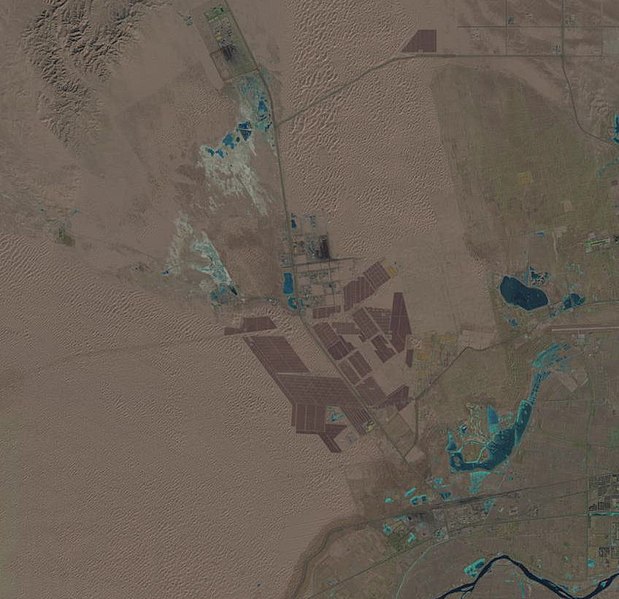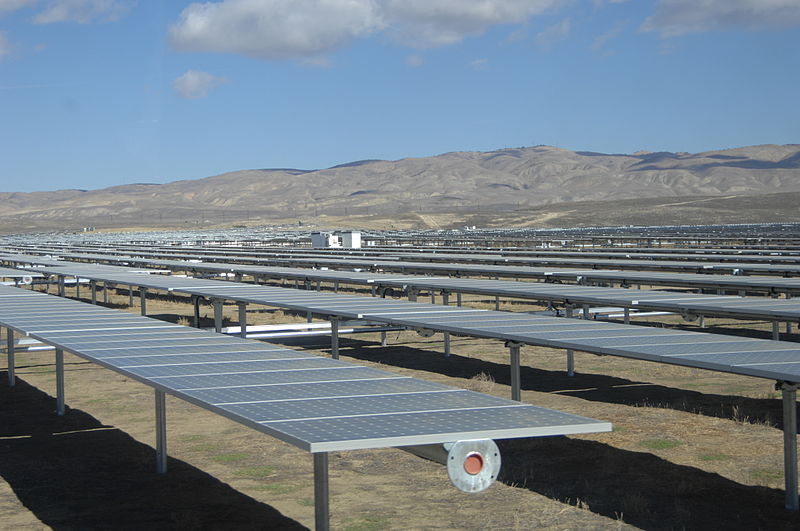Solar farms have rapidly emerged as powerful contributors to the global shift toward renewable energy, harnessing the sun’s abundant power to generate clean electricity on an unprecedented scale. These massive installations, often spanning thousands of acres, produce enough energy to power entire cities, highlighting the incredible potential of solar technology in tackling climate change. With advancements in photovoltaic technology and a push for sustainable development, solar farms are becoming a cornerstone of many countries’ energy strategies. This list explores some of the largest solar farms in the world, showcasing their impressive capacities, innovative designs, and the critical role they play in reducing carbon emissions and supporting energy independence.
Bhadla Solar Park – India

Bhadla Solar Park, located in the harsh desert climate of Rajasthan, India, covers approximately 14,000 acres, which is equivalent to about 56 square kilometers. With its massive capacity of 2,245 MW, it powers millions of homes, contributing significantly to India’s clean energy goals. The project is part of India’s ambitious target to reach 100 gigawatts of solar energy by 2022, showcasing its dedication to renewable power. Situated in an area with intense sunlight, Bhadla operates with remarkable efficiency year-round. The park’s establishment has boosted the local economy, providing jobs in construction, maintenance, and operations. Its success has inspired similar solar projects across India. Bhadla is not only an achievement in energy production but also a symbol of sustainable progress for the region.
Tengger Desert Solar Park – China

Known as the “Great Wall of Solar,” the Tengger Desert Solar Park in Zhongwei, Ningxia, China, spans over 16,000 acres, harnessing the desert’s abundant sunlight. With a capacity of 1,547 MW, this massive solar array provides power to hundreds of thousands of households in the surrounding regions. China, being one of the world’s top carbon emitters, sees this project as a crucial step in its commitment to reducing carbon emissions. Located in a sparsely populated desert, the solar park doesn’t compete for land with agricultural or urban areas, making it an ideal renewable energy site. Tengger also highlights China’s cutting-edge power infrastructure, with high-voltage power lines transporting electricity efficiently across vast distances. The project has paved the way for even larger renewable energy installations in China. Its scale reflects the country’s dedication to green technology and sustainable development.
Pavagada Solar Park – India

The Pavagada Solar Park, located in Karnataka’s Tumkur district, covers about 13,000 acres and currently has a capacity of 2,050 MW. Positioned in a sun-rich area with favorable topography, it generates power reliably throughout the year. The project is innovative in its approach, leasing land from local farmers who receive steady income, enhancing their livelihoods. Pavagada represents the government’s commitment to renewable energy, aiming to reduce India’s carbon footprint by replacing fossil fuels with solar power. Additionally, the park’s success has attracted both national and international investors, signaling confidence in India’s clean energy sector. The initiative serves as a model for large-scale solar projects in other regions. With its vast expanse, Pavagada stands as a testament to sustainable economic and environmental growth.
Benban Solar Park – Egypt

Benban Solar Park, situated near Aswan, Egypt, is the largest solar farm in Africa, spanning approximately 14,000 acres with a capacity of 1,650 MW. This project aligns with Egypt’s renewable energy goals, which include producing 20% of its power from renewable sources. The site leverages Egypt’s high solar potential due to its consistent sunshine and optimal geographic position. Attracting significant foreign investment, Benban has fostered international partnerships that promote sustainable energy in North Africa. It provides thousands of jobs for local communities, supporting economic development. The electricity generated here reduces Egypt’s dependency on fossil fuels, making it a critical component in the country’s energy transition. As a prominent renewable installation, Benban is reshaping Africa’s energy landscape.
Noor Abu Dhabi – United Arab Emirates

The Noor Abu Dhabi solar project, located in Sweihan, is the largest single-site solar installation in the world, covering 7.8 square kilometers. With a capacity of 1,177 MW, Noor Abu Dhabi powers around 90,000 households across the UAE. The project contributes to Abu Dhabi’s environmental goals, reducing carbon emissions by up to 1 million metric tons annually, which is equivalent to removing about 200,000 cars from the roads. Strategically positioned in a sun-rich desert area, Noor Abu Dhabi operates with optimal efficiency, taking advantage of the country’s ample sunlight. The project is a cornerstone of the UAE’s plan to diversify its energy sources and reduce reliance on oil and gas. As a result, Noor Abu Dhabi has positioned the UAE as a leader in the global renewable energy sector.
Mohammed bin Rashid Al Maktoum Solar Park – United Arab Emirates

Spanning over 16,000 acres, the Mohammed bin Rashid Al Maktoum Solar Park in Dubai currently produces over 1,013 MW of energy, with plans to expand to 5,000 MW by 2030. This park is central to Dubai’s Clean Energy Strategy, which aims to generate 75% of Dubai’s energy from clean sources by 2050. The multi-phase project employs various technologies, including photovoltaic panels and concentrated solar power systems, setting a precedent for advanced solar farms worldwide. As part of a wider effort to reduce carbon emissions, the park is instrumental in meeting Dubai’s ambitious sustainability goals. The project has attracted investments from both the public and private sectors, enhancing its impact on the region’s economy. Mohammed bin Rashid Al Maktoum Solar Park is a beacon of innovation in the Middle East’s renewable energy landscape.
Kurnool Ultra Mega Solar Park – India

The Kurnool Ultra Mega Solar Park, situated in Andhra Pradesh, India, spans around 5,932 acres and has a capacity of 1,000 MW. It powers hundreds of thousands of homes, supporting India’s broader renewable energy objectives. Strategically located in a region with high solar irradiance, the park is capable of generating large amounts of clean energy year-round. Kurnool has created numerous jobs for local residents, strengthening the regional economy. Its development set a precedent in India for affordable solar power production, influencing similar projects. By reducing greenhouse gas emissions, Kurnool aligns with India’s climate commitments. It represents a significant step in India’s journey towards sustainable energy.
Longyangxia Dam Solar Park – China

The Longyangxia Dam Solar Park, located in China’s Qinghai province, combines solar energy with hydroelectric power, boasting a capacity of 850 MW. Spanning over 10,000 acres, the solar panels work alongside the Longyangxia Dam’s hydropower plant to create a reliable energy source. This hybrid system mitigates fluctuations in solar power by storing excess energy in the hydropower reservoirs. The innovative design has garnered international attention, showcasing China’s expertise in renewable energy. The solar park’s success demonstrates the potential of hybrid renewable systems in addressing energy needs. This setup has become a model for future energy projects. Longyangxia reduces reliance on coal, supporting China’s environmental policies.
Copper Mountain Solar Facility – United States

The Copper Mountain Solar Facility, located in Boulder City, Nevada, spans roughly 4,000 acres and has a capacity of 802 MW, making it one of the largest solar farms in the United States. Its location in Nevada, a state known for its sunny climate, allows it to operate year-round with maximum efficiency. The facility provides clean energy to over 260,000 homes, contributing significantly to Nevada’s renewable energy portfolio. Copper Mountain’s development has been a key player in Nevada’s economic growth, creating jobs and fostering local clean energy industries. The facility is an example of large-scale solar farms’ capability to power entire communities with minimal environmental impact. It underscores the role of renewable energy in shaping a sustainable future for the U.S. As one of the nation’s flagship solar projects, Copper Mountain sets a high standard for green energy infrastructure.
California Valley Solar Ranch – United States

Situated in San Luis Obispo County, California Valley Solar Ranch spans over 4,700 acres, with a capacity of 250 MW, making it a significant source of renewable energy in California. This solar ranch supplies electricity to over 100,000 homes and plays a crucial role in meeting California’s stringent clean energy goals. The facility is located on former ranch land, utilizing otherwise unused areas to produce solar power without impacting residential or agricultural zones. Advanced photovoltaic technology allows for efficient power generation, even on cloudy days. The California Valley Solar Ranch has helped drive renewable energy initiatives across the state, promoting clean energy investment and innovation. Its success has positioned it as a leader among sustainable projects. This facility is a model for effectively combining environmental responsibility with economic growth.
Setouchi Kirei Mega Solar Power Plant – Japan

Setouchi Kirei Mega Solar Power Plant is Japan’s largest solar farm, covering approximately 1,210 acres in Okayama Prefecture. With a capacity of 235 MW, the plant provides energy to thousands of homes, bolstering Japan’s renewable energy sector. The plant was developed as part of Japan’s increased focus on renewables after the 2011 Fukushima disaster, emphasizing the country’s shift towards safer energy alternatives. Its location near water, with floating solar panels, demonstrates innovative approaches to land use for clean energy. Setouchi’s impact extends beyond energy production, attracting further investment and innovation in Japan’s renewable market. The facility reduces Japan’s carbon footprint, contributing to the country’s climate goals. It serves as a significant step in Japan’s transition to sustainable energy sources.
Perovo Solar Park – Ukraine

Located in Crimea, Ukraine, Perovo Solar Park covers 1,270 acres and has a capacity of 100 MW, making it one of Eastern Europe’s largest solar installations. The facility contributes to Ukraine’s efforts to diversify its energy sources, reducing reliance on imported natural gas. Perovo Solar Park is situated in a region with high solar irradiance, ensuring efficient year-round energy production. The project underscores Ukraine’s commitment to energy security and sustainable development. It also reduces greenhouse gas emissions, aligning with the country’s environmental objectives. Perovo Solar Park has become a landmark renewable energy project in the region. This facility showcases Ukraine’s potential to lead in clean energy within Eastern Europe.
This article originally appeared on Rarest.org.
More From Rarest.Org
17 Oldest Cities in Florida

Florida is known for its beaches and sunshine, but it’s also home to some of the oldest cities in the United States, each with its own unique history and charm. From Spanish colonial settlements to historic river towns and early frontier outposts, these cities capture the story of Florida’s growth over the centuries. Read more.
When it comes to shopping, some malls take things to a whole new level. These massive complexes are more than just places to shop. They offer entertainment, dining, and endless experiences under one roof. Read more.
England is home to some of the oldest pubs in the world, each with its own fascinating history. Many of these establishments date back centuries, serving as places of rest for travelers, gathering spots for communities, and witnesses to key historical events. Read more.


